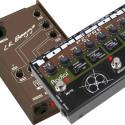What is a DI Box? A Clear Sound Explanation

When working as a DJ or a sound engineer, there will be a lot of equipment to get used to. The more gear you know about, the more tools you have to make fantastic music.
One piece of equipment you should look into is a DI - but what is a DI, and how can it change your performance?
Here, I am going to be talking all about DI boxes. This way, you can have a comprehensive guide to DI boxes to meet all your needs.
Defining DI Boxes
A DI, or DI box, is a piece of audio equipment used in musical performances and recordings.
The DI stands for 'Direct Injection' box. DI boxes are also called direct boxes - but both names refer to the same thing.
They are small rectangular boxes with at least one input and output jack, usually an XLR output. This makes them one of the more accessible pieces of equipment sound technicians, DJs, and musicians can use.
What Is A DI Box Used For?
The primary function of the best DI box is to convert impedance for impedance matching. Another use is signal balancing, it splits a signal with a "thru out" that takes the dry, unconverted signal through to an amplifier while the XLR output carries a balanced signal to a mixer. A balanced signal is more resistant to interference, making DI boxes ideal for long cable runs in big venue setups.
Understanding Impedance
In physics, resistance is the measure of the opposition working against an electrical current's flow in a circuit. Impedance is resistance in alternating currents (ACs).
Electrical audio signals count as a type of AC. Different electronic instruments have different impedance. You can have instruments with high or low impedance, which can cause slight issues when hooking them up to audio interfaces indiscriminately.
Impedance And Recording Audio
When electric guitars began to take over acoustic guitars, their audio signals were recorded through a microphone placed in front of their sound source - like an amplifier.
Eventually, technicians wanted to try recording the electronic signal directly from the instrument and feeding it into the mixing console. This would skip the conversion of electric to acoustic signals through the microphone.
However, electronic instruments were not easily compatible with mixing consoles. Their impedance was too high compared to the output signals of microphones. This affects the input gain structure and introduces noise since the gain required would be higher than usual.
So, to feed an electronic instrument signal path directly into an audio interface, you need to convert the impedance so the signal is strong enough.
To do this, you will need a direct box.
DI boxes can convert or change that impedance. This allows you to plug instruments and unbalanced microphones into the equipment they are usually incompatible with.
So, DI boxes hook up electric instruments directly to equipment like mixing consoles.
How A DI Box Works
Let's get into how a direct box functions.
It works by matching the output level of your electronic instrument to a microphone level.
This is done by converting unbalanced output signals into balanced signals. Electromagnetic instruments give out unbalanced output signals, while microphones don't.
A DI box suppresses any ground loop noise (and additional noise like humming) to balance the signal. This can reduce impedance so high impedance instrument signals match microphone input signals.
As a result, a mixing desk can pick up this instrument input because it matches a mic input gain level.
Why We Use DI Boxes
So, a direct box can connect electronic musical instruments directly to mixing consoles and more - but why? What effect does this have? Do you need a DI box?
-
The main benefit of a direct box is that you can skip out on using microphones, a mic preamp, or instrument amplifiers. These pieces of equipment can be costly, so using a di box is a more affordable option. With VST plugin amplifier simulations excellently emulating the real thing, project studios benefit from using DI tracks for their guitars.
-
You can also use a stereo DI box for stereo output electronic instruments. This means you don't have to use multiple amplifiers for multiple outputs. An electric guitar amplifier will only work for an electric guitar. However, a single stereo DI box lets you plug a stereo-out synth or keyboard into the board.
-
DI boxes also reduce electrical noise in unbalanced signals. Microphones can pick up external noise in the control room when recording live sound. A DI box provides a balanced output signal that is cleaner.
These are the main benefits of using a DI box.
Other Ways To Use A DI Box
Although the primary function of a DI box is to convert impedance, it can also be used in different ways. It's a versatile piece of equipment for DJs and musicians.
Here are the three main alternative ways DI boxes are used:
-
Isolating instruments and removing noise bleed from audio.
-
Record direct guitar signals for mixing.
-
Some variants of DI boxes allow you to re-amp guitar signals when switching to a different rig.
Types Of DI Boxes
If you want to try using your driver box, you must pick the right type. There are lots to choose from, so let's look closer.
Active Direct Box
Active DI boxes require their external power source. You can power your active DI box through batteries or phantom power through a balanced XLR output.
Their input impudence level is also high.
An active DI box works better for passive sources of output. These include bass guitar, acoustic guitar, and more.
Passive Direct Box
Passive direct boxes are the opposite of active DI boxes. They don't require a power source - so no batteries or phantom power is needed.
They also have a low impedance input signal. So, they are great for converting a high impedance instrument signal into the low impedance signal you need for your audio interface.
As a result, they are better used for active instruments with their power source and high impedance signals. This includes a bass guitar, electric guitar, and more. If you have an acoustic guitar with a built-in preamp - you can hook it up to a passive direct box.
Re-Amp Box
These are DI boxes that have been wired differently. The input is found on the XLR side of the box, and the output is on the 1/4-inch side instead.
This different interface can come in handy for reamping DI guitar tracks.
Speaker Simulation
These DI boxes connect guitar amplifiers to mixing consoles through a balanced signal. Analog speaker sims use circuitry that emulates speakers. Other modern DI Boxes now include Impulse Response loaders. This is handy for silent stage volumes or direct recording without a guitar cabinet.
Frequently Asked Questions
What should I look for in a DI box?
There are many active and passive di boxes features to consider before purchasing. Here are some ideas to get you thinking:
-
You will want a DI box with a ground lift switch. Ground lift switches break ground loops that cause noise. So, a DI with a switchable ground lift is something to consider.
-
A switchable gain attenuator (or a pad) helps stop the circuits in the direct box from overloading.
-
Direct boxes with a thru or bypass can divide an input signal to send it to multiple channels like amplifiers or PA systems.
Are active direct boxes better than passive DIs?
It would be best to choose an active or passive di based on the power source of your instrument.
A passive DI box has a lower input impedance than active DIs. So you need to match the correct DI box to the right instrument to get the right balanced DI signal - or it won't work.
Final Thoughts
So, what is a DI?
It's a piece of equipment used by sound engineers to change the impedance in an electric instrument's direct signal. They turn an unbalanced signal into a balanced one so electric instrument signals can work with a mixing console directly.
They offer many benefits, so you should get one to help you record or perform music.












